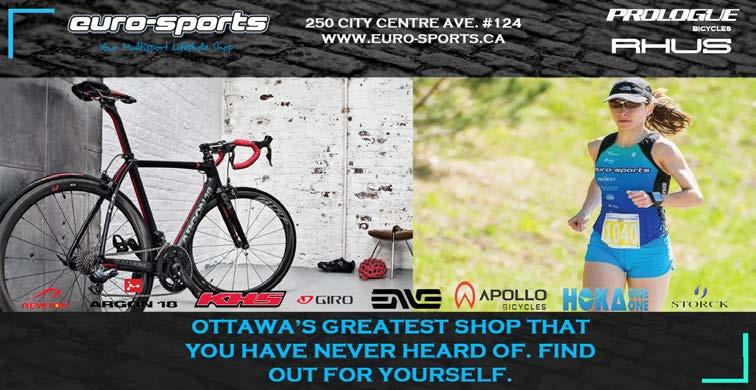
3 minute read
How to buy a bicycle
By Allen Macartney
Carefully.
Advertisement
If you’re looking toward a new bicycle this spring and not sure where to start, give a listen to Chris Chapman of Mountain Equipment Co-op.
Ottawa Outdoors Magazine asked him to steer us through the maze of choices. To narrow down the options, we assumed a buyer would cycle 500 to 1,000 kilometres a year mostly on paved and crushed stone pathways, on a budget of less than $700.
OOM: How much do I have to pay to get a good bike that will meet my needs?
MEC: You’ll easily find a good bike with a light alloy frame within your stated budget. It will have quality, brand name components (e.g. brakes, shifter) that are perfectly twinned so they work well together. Poor quality components often found in cheap department store bikes won’t stand up to years of worryfree use.
OOM: What type of bicycle should I buy?
MEC: If you’re not going off-road along rough forest trails, you don’t need a mountain bike. They’re slow and have big tires that can absorb shock. If you want to take your time on paved and crushed stone pathways while enjoying the scenery, a hybrid bike is the best choice. Hybrids are safer than road bikes (sometimes called racing bikes) for city riding – the more upright position means you can see over the traffic.
Then you need to make a choice in tires – wide ones all the way to fairly narrow, but not as narrow as racers. Hybrids give you great flexibility.
OOM: What are the options?
MEC: A fairly wide tire with thick tread will be slower than a narrower one with a light tread. Or you can choose a tire with a smooth middle portion (for fast riding) with tread on the sides (for cornering). This is a good compromise and offers you the best of both worlds.
OOM: Do I need disk brakes?
MEC: MEC only puts disk brakes on more expensive bikes – ones over $1,000. They give better stopping performance, but you probably don’t need it with your cycling profile. You’re better riding with expensive rim brakes rather than inexpensive disk brakes. Always go for quality.
OOM: What about shock-absorbing forks?
MEC: Forks are great if you’re going to cycle on rough trails. They dampen vibrations but in your case they’re probably not necessary.
OOM: How should I choose handle bars?
MEC: Hybrid bikes offer many choices depending on how you want to ride. Flat bars are popular, but many people also like a handle bar that is higher. It allows you to sit up straighter and get a better view of your surroundings. All handle bars can be adjusted for comfort, and the vertical stem can be adjusted too.
OOM: Are test rides necessary before I buy?
MEC: Absolutely! You don’t buy shoes before trying them on and walking around. It’s the same with a bike. Your test ride should be about 20 minutes long. Ask yourself, does this feel comfortable? Is it a joy to ride? Am I stretching uncomfortably anywhere? Is the frame too tall or short? A salesperson should adjust the bike to your fit before your test ride: slide the saddle forward/
MEC: Keep your bike well maintained. Depending on your riding style, that might just involve wiping the chain weekly and oiling all moving parts. Bringing your bike in for a minor tune-up ($40 cost) every year will make it last a very long time. Also pump your tires up to almost the maximum tire pressure. They’ll last longer and help y ou ride faster.
back and up/down, move the handlebars into a comfortable position. Your back will appreciate it!
OOM: What about the seat?
MEC: Again you have many choices: wide to very narrow. Women often prefer a wider saddle while men often choose a longer, thinner one with a groove down the middle to accommodate their physique. Wider saddles encourage a rider to sit up, while narrow saddles help you lean forward and lower. Some excellent bike seats go for as little as $15 so don’t spend too much needlessly. Try several out before buying.
OOM: Any parting advice?









